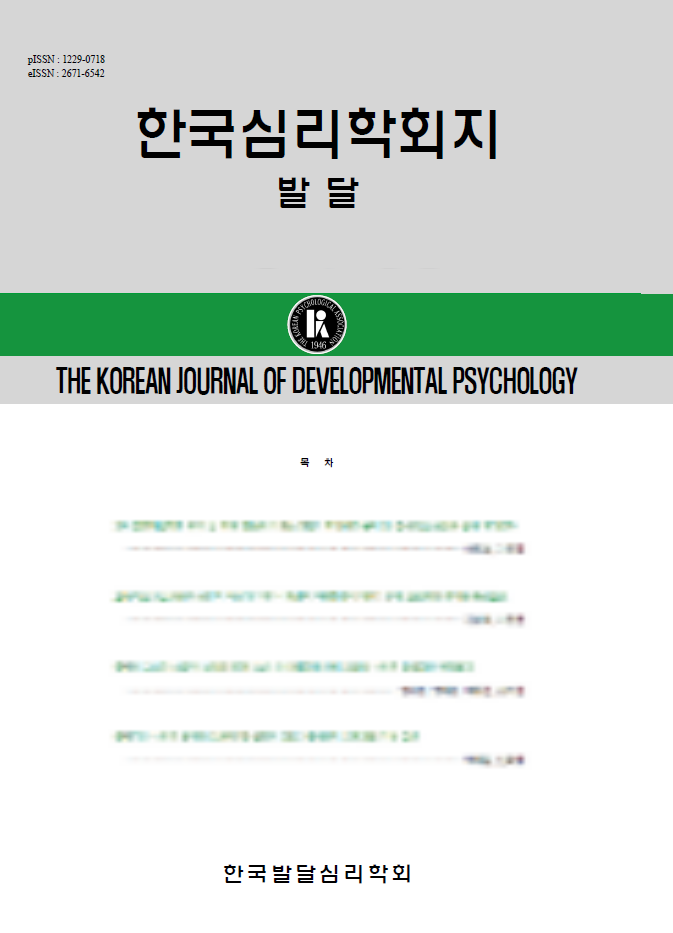open access
메뉴
open access
메뉴 ISSN : 1229-0718
ISSN : 1229-0718

본 연구는 중학교 1, 3학년, 고등학교 2학년, 그리고 대학생 등을 대상으로 사회적 역할에 따른 자기표상을 자유롭게 기술하도록 하여 자기표상의 내용과 구조가 어떻게 변화하는지 살펴보았다. 자기표상의 내용은 성격특성, 감정특성, 행동특성, 소망특성으로 범주화하여 학년에 따라, 사회적 역할에 따라 구성 비율을 비교하였고, 자기표상의 구조는 역할들 간에 중복된 자기표상의 비율, 자기표상의 다양성비율, 대립 및 갈등을 경험한 자기표상의 비율을 학년에 따라 비교하였다. 연구 결과, 자기표상의 내용은 학년이 증가함에 따라 감정적인 특성은 감소하고, 추상적, 안정적인 성격특성은 점차 증가하였다. 특히, 부모님과 있을 때는 다른 역할에 비해 감정특성이 많이 보고되었고, 또래와 있을 때는 성격특성을 비교적 많이 보고하였다. 자기표상의 구조는 학년이 증가함에 따라 분화되었고, 분화된 자기의 다중성으로 인한 모순과 갈등도 더 많이 보고하였다. 이러한 결과는 청소년기 자기표상이 추상적으로 변하고 구조적으로 분화된다는 선행연구들과 일치하는 것이었으나 분화의 시기나 정도에 있어서는 차이를 보여 자기표상의 형성에 미치는 문화적 영향을 간접적으로 확인해 볼 수 있었다.
For this study, 328 students from 1st-, 3rd-grade middle school, 2nd-grade high school, and undergraduates were asked to generate role-related self-representations. Then, the contents and the construct of self-representations were analyzed through these self-descriptors. The results were as follows: First, as the grades became higher, characteristic attributes were increasing, and emotional attributes were decreasing. In addition, selves with parents were more emotional and selves with friend group were more abstractive and stable. Second, as the grades became higher, self-representations were more differentiated and the more opposition and conflicts were perceived. Through the result of this study, it was confirmed that self-representations from diverse social contexts were more abstractive and stable in their content and were differentiated in their construct during adolescence. However, in comparing with preceding research, there were differences in the time and the degree of self-proliferation. This may means cultural differences in a development of self-representations.
김기정, (1988) 청소년기의 자기개념의 발달적 변화:문헌적 고찰.논문집, 서원대학
김인경, (1987) 인지발달과 지각된 부모의 양육태도 유형에 따른 청소년기 자기중심성의 발달 양식,
김인경, (1988) 청소년기의 자기중심성에 관한 연구:인지발달 및 지각된 부모의 양육 유형과의 관계, 한국심리학회지
김현경, (1985) 청소년의 대인관계와 자아개념과의 상관연구,
장휘숙, (1999) 청년심리학, 학지사
차영준, (2001) 비모수검정, 자유아카데미
한석규, (2002) 사회심리학의 이해, 학지사
허혜경, (2002) 청년발달심리학, 학지사
Adams,E.M., (1988) Emotional intelligence and wisdom, The Southern Journal of Philosophy
Allport,G.W., (1961) Patterns and growth in personality, Holt, Rinehart, & Winston
Bresnick.S., (1986) Conflict in the adolescent self theory. Unpublished honors thesis, University Denver, Denver, Co,
Bresnick,S., (1995) Developmental and gender differences in role-related opposing attributes within the adolescent self-portrait. Unpublished doctoral dissertation, University Denver, Denver, Co,
Bukarko, D., (2001) Child Development: A Thematic Approach, Houghton Mifflin Compay
Cooley,C.H., (1902) Human nature and the social order, Charles Scribner's Sons
Cousins,S.D., (1989) Culture and self-perception in Japan and the United States, Journal of Personality and Social Psychology
Crockett,W.H., (1965) Cognitive complexity and impression formation in : Progress in experimental personality research, Academic Press
Epstein,S., (1973) The self-concept revisited, American Psychologist
Fischer,K.W., (1980) theory of cognitive development: The control and construction of hierarchies of skills, Psychological Review
Fischer, K. W., (1986) The ambiguity of stage and structure in behavior: Person and environment in the development of psychological structure in : Stage and structure: Reopening the debate, Plenum
Flavell, J. H., (2003) 인지발달, 시그마프레스
Gergen,K.J., (1968) Personal consistency and the presentation of self in : The self in social interaction, Wlley
Grotevant, H. D., (1986) Individuation in family relationships, Human Development
Hart,D., (1988) The adolescent self-concept in social context in : Self, ego, and identity, Springer-Verlag
Harter, S, (1992) Developmental Analysis of Conflict Caused by Opposing Attributes in the Adolescent Self-Portrait, Developmental Psychology
Harter, S., (1997) The development of multiple role-related selves during adolescence, Development and Psychopathology
Harter,S., (1999) The Construction of the Self, Guilford Press
Higgins, E. T., (1988) Do self-attributes form a cognitive structure, Social Cognition
Hill, J. P., (1986) Attachment and autonomy during adolescence in : Annals of child development, JAI Press
James,W., (1890) Principles of psychology, Holt
James,W., (1892) Psychology: The briefer course, Holt
Kanagawa, C., (2001) ).“Who Am I?” The Cultural Psychology of the Conceptual Self, Personality and social psychology bulletin
Keating,D.P., (1990) Cognitive processes in adolescence in : At the threshold: The developing adolescent, Harvard University Press
Lawson,A.E., (1978) The development and validation of a classroom test of formal reasoning, Journal of Research and Scientific Teaching
Leahy, R. L., (1995) 자기의 발달, 문음사
Lecky,P., (1945) Self-consistency: A theory of personality, Island Press
Lifton,R.J., (1993) The protean self, Basic Books
Markus, H., (1990) The interpersonal self in : of personality: Theory and research, Guilford Press
Mead,G.H., (1934) Mind, Self, and Society, The University of Chicago Press
Montemayor, R., (1977) The development of self-conceptions from childhood to adolescences, Developmental Psychology
Piaget, J., (1932) The moral judgment of the child, Free Press
Piaget,J., (1960) The psychology of intelligence, Littlefield, Adams
Rosenberg,M., (1986) Self-concept from middle childhood through adolescence in : Psychological perspective on the self, Erlbaum
Rosenberg,M., (1988) Self and others: Studies and Social Personality and Autobiography in : Advances in experimental social psychology, Academic
Scarlett, H. H., (1971) Children's descriptions of peers: A Wernerian developmental analysis, Child Development
Smollar, J., (1985) Adolescent self-concept development in : The development of the self, Academic Press, Inc
Snyder,M., (1987) Public appearances. private realities: The psychology of self-monitoring, Freeman
Sullivan,H., (1953) The interpersonal theory of psychiatry, Norton
Volpe,J., (1980) The development of concepts of parent-child and friend relations and of self within these relation, The Catholic University of America
Wener,H., (1961) Comparative psychology of mental development, Science Editions
Youniss,J., (1980) Parents and peers in social development, University of Chicago Press
